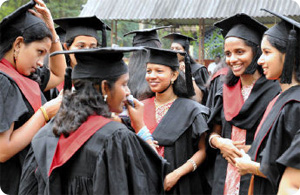Education in India

India has been an ancient seat of learning and was often visited by travelers who came to India to study in the ancient Indian institutions. Education flourished at Nalanda, Takshashila University, Ujjain and Vikramshila Universities. Infact, the Gurukul system of education is one of the oldest educational institutions in the world. The Mughal period saw the inception of Madrasahs in the education system in India. During the British rule in India in the 18th century, education was widespread. English happened to be the medium of instruction for the Western education introduced by the British in India.
In the modern times, there are numerous schools, colleges, universities and other institutions in India that are continuously providing education to the students.
The introduction of English education in India benefited a handful of the population and this gave rise to the western educated middle class intelligentsia who organized the Indian masses in the struggle for freedom. The British established many colleges in India, such as, the St. Xavier's ollege, Sydenham College,Wilson college and Elphinstone College.
After independence, education became the responsibility of the states. The Indian education system is generally marks based. There are broadly four stages of school education in India, namely primary, upper primary, secondary and higher secondary (or high schools). The primary or the elementary education is the foundation of the education system in India, as the children are given eight years of schooling during this period. After completing the elementary education, the students get into the secondary level.
The government has taken up the responsibility for ensuring universal elementary education (primary and upper primary) for all children between the age group of six to fourteen. From class one to five is the primary school from the age group of six to eleven. Upper Primary and Secondary school pupils are aged between eleven to fifteen years organised into classes six to ten. The higher secondary school student ages sixteen to seventeen enrolled in classes eleven and twelve.
The undergraduate and postgraduate levels constitute the higher education. At this stage, a student chooses his/her most favourite subject in which he/she is intending to pursue career. The students also put on lots of efforts to be successful in this stage. They are taught the skills and knowledge needed for them to be successful while working in different professional environments, in this stage. The students also get into different professional courses at this level and the courses help them to be in a better position.
Higher education or the university education in India has evolved in distinct and different streams. Most universities are administered by the states, however there are eighteen important universities called Central universities, which are maintained by the Union Government. Private sector has also come up in the Indian higher education and this is creating greater opportunities for education in India. The nicely segmented and well organized education system in India has been working wonderfully and producing well educated people in India, for the past several years.
| |
Other Categories
Foreign Degrees in India
Career Options after HSC
Entrance Test Examinations
International Examinations
Competitive examinations in India
Education in India
Colleges In Indian States
Medical Colleges in India
Management Courses in India
Engineering Courses in India
Professional Courses in India
Academic Degree Course In India
Education Governing Bodies
Indian Education System
Women Education in India
Structure of Indian Education
IITs in India
Development of Education in India
Online education in India
Gurukul
Education in Modern India
|

